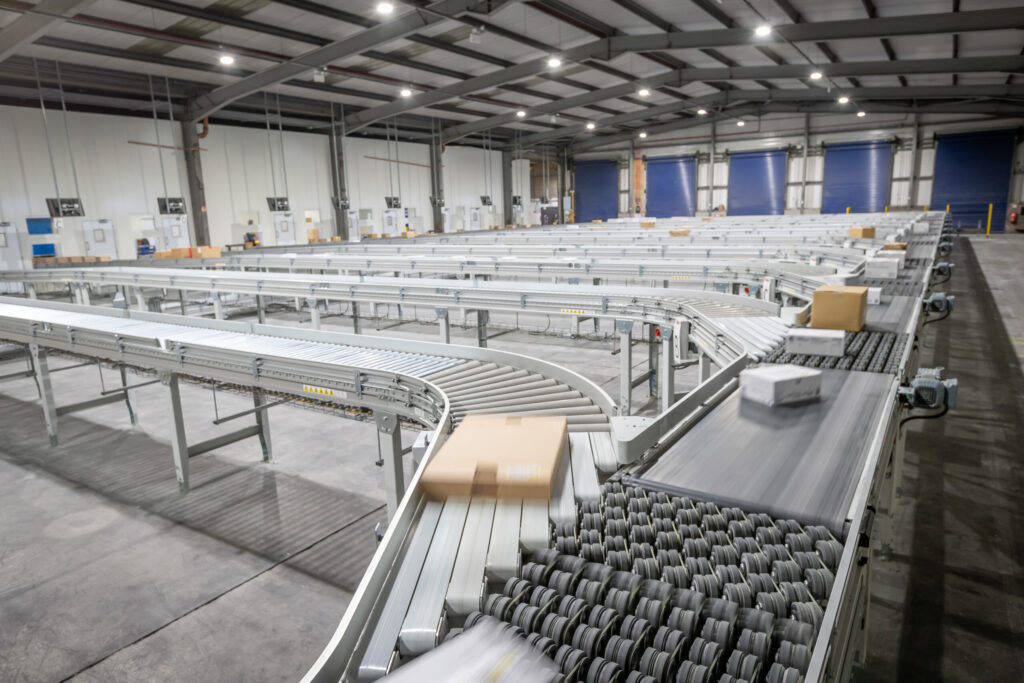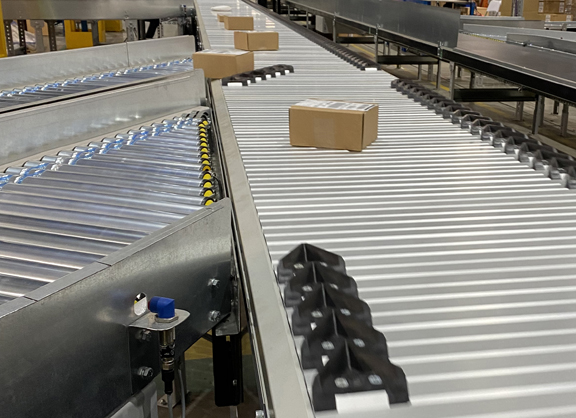
Cross-docking material handling systems reduce labour and storage requirements, and hence a reduction in distribution costs, where bulk sorting of product is required. Cross-docking order fulfilment is applicable to wholesalers, courier companies, and other transfer points for products and packages such as 3pl’s, where pallets or bins of a product are presented and need to be split into multiple destinations or orders.
What are the elements to a successful cross-docking automation project? This post will highlight the material handling solutions required for a successful automation solution and how Axiom GB can assist in a successful turn-key project.
What is cross-docking for warehouse & distribution logistics?
A cross-docking material handling system describes an approach to supply chain management that involves the transfer of products from the inbound carrier to outbound transportation without entering the warehouse for storage, hence ‘crosses the docks’ bypassing the warehouse, as goods transfer from the receiving dock directly to the shipping dock for ongoing transportation.
At first glance, this broad definition might seem like a simple process, but consolidation, product tracking and coordination complicate the procedure. Often the product will require sorting to a specific destination or delivery route. A new outbound shipper label may be required, along with checking the product or package for weight and volumetric dimensions to ensure this matches the pre-entered data, also to calculate shipping rates and transport optimisation. Good cross-docking practices can result in substantial inventory savings as this eliminates the need to store products onsite.

Why is cross-docking for warehouse & distribution logistics important?
Cross-docking is a practical example of a core pillar of the lean philosophy in the elimination of non-productive tasks. Whilst lean principles coalesced around the Toyota Production System (TPS) for the just-in time manufacture of motor cars, lean philosophy can be applied to all operations.
Cross-docking distributes goods directly from inbound receipt, from the manufacturer or supplier to the outbound transport without the unnecessary multiple handling of storing and retrieving of the traditional routing of goods to storage areas and racks, to be retrieved at some future time back to the dispatch areas.
Distribution Centres (DC’s), 3pl’s, wholesalers, and transport hubs favour cross-docking because it presents the opportunity to reduce or eliminate inventory, or work-in progress (WIP), while the cost of material handling is drastically reduced. Manufacturers prefer cross-docking because it expedites shipments and improves customer satisfaction.
With the squeeze on labour availability and increases in costs for those available, the reduction in required labour used for cross-docking compared with conventional store and retrieval systems already has a return on investment (ROI). Add in lower floor space of automated solutions and reduction in losses caused by misplaced or damaged stock then cross-docking looks like a winning materials handling system. A report from Turner & Townsend shows how the availability and costs in the UK, of both labour and warehousing, are still an ongoing concern.
When to use cross-docking for warehouse & distribution logistics.
Cross-docking is at its most efficient when applied to the following products or merchandise:
- Back-ordered items; late supply of products required for order fulfilment prevent stocking into the warehousing and require direct shipping after goods inbound. To fulfil an order, both stored and back-ordered goods may be paired during cross-docking for a single shipment.
- Seasonal merchandise: because the product has a short shelf-life either due to calendar events or durability of the product itself, any time in storage could damage sales or life expectancy. Cross-docking through the distribution process allows immediate customer fulfilment.
- High-volume or high-value products; both of these have unnecessary costs added if they are committed to intermediate handling, such as warehousing. High-volume will lead to excessive traffic within a warehouse if stocked; high-value items will have negative cash-flow implications if stocked for any length of time.
- Short lead-time products; where products have a short lead-time from order through to delivery to the distribution network, it makes little sense to hold a large stock, as replenishment is instantaneous.
Cross-docking constituent parts
Axiom, a leading UK-based materials handling systems manufacturer, is a supplier of cross-docking cells both in the UK and worldwide. Typically a cross-docking cell will comprise four (4) main components arranged to suit the individual facility and customer requirements to allow efficient order fulfilment.
Induct:
This is where the product is loaded onto the cross-docking cell from the inbound pallet. The size and number of inducts will depend on the throughput required and the size & weight of the products to be managed. If the product consists of boxes or other rigid packages arranged as layers on a pallet, automated depalletisation may be possible.
Conveyors:
The heart of the cell, the conveyor system can be a combination of belt, powered roller and gravity roller conveyor systems. Where buffering or accumulation is required, especially at the outbound ends, zero line pressure (ZLP) roller conveyor systems will be implemented. Here the conveyor comprises a series of unique short conveyor sections each with individual drive, control and sensor modules allowing high-density queuing of packages, without back-pressure.
Package Registration:
Typically installed after the induct area, the system dynamically reads a bar or QR code label on the package to log this to the cell control system as the product passes along the conveyor. The cell control system manages the data and passes to the customers’ warehouse management system (WMS) to return the destination that the package is required at. The system may consist of scanners only or with the addition of volumetric measuring and weighing systems. If a full dimensioning; weighing & scanning (DWS) system is used, this will enable the recording of the package code, dimensions and weight. This data can be compared with the supplied data from the WMS and help with load optimisation for the outbound delivery.

Sortation:
Once the product is loaded onto the cross-docking system and the data logged to the WMS, the product needs to be diverted to the required outbound leg. Axiom are the only UK designer and manufacturer of sortation equipment. For cross-docking cells either Swivel Wheel Sorters (SWS) or Sliding Shoe Sorters are specified. The type and specification of sorter required will depend on the project requirements
The benefits of using cross-docking for warehouse & distribution logistics
Cross-docking allows for an efficient materials handling solution to reduce labour, handling and storage requirements, allowing products to be inbounded and distributed within a DC, warehouse or distribution hub, whilst tracking each package versus customer orders and providing real-time data for the business and WMS.
- Reduced handling costs: Cross-docking reduces the amount of handling required for goods, reducing the labour and equipment costs associated with handling and storing goods.
- Faster turnaround time: Cross-docking eliminates the need for storage, allowing goods to be quickly sorted and shipped to their final destination. This reduces the time to market, improving customer satisfaction.
- Lower inventory costs: With cross-docking, inventory levels can be kept lower because goods are moved quickly from suppliers to customers. This reduces the inventory that needs to be stored, lowering costs associated with warehousing and inventory management, improving the business cash-flow.
- Improved supply chain efficiency: Cross-docking can help businesses improve supply chain efficiency by reducing transit time, improving product flow, and reducing the risk of inventory obsolescence.
- Improved flexibility: Cross-docking enables businesses to quickly respond to changes in demand by adjusting the flow of goods through the facility. This helps businesses to be more agile and responsive to market changes.
- Reduced transportation costs: By consolidating shipments and reducing the number of times goods are handled, cross-docking can lower transportation costs.
Overall, a warehouse cross-docking facility can help businesses improve efficiency, reduce costs, and improve customer satisfaction. However, it may not be suitable for all types of products or supply chain operations, and careful planning and management are required to ensure its success.
Why Axiom GB Ltd?
Axiom are a family business based in Tamworth, Staffordshire, UK. The company has 25-years of experience as a leading supplier of material handling automation solutions across a range of industries, but specialising in the supply of systems for logistics, warehousing and fulfilment applications. The combination of conveyors, sorting systems, control and data handling provides turnkey projects for many well-known companies.
By reviewing each project on its own merits, Axiom strives to provide the optimum solution to exceed the base requirements of the automation.
Let’s talk….
We’d love to help you solve your materials handling challenges.
Contact Us
+44(0)1827 61212
